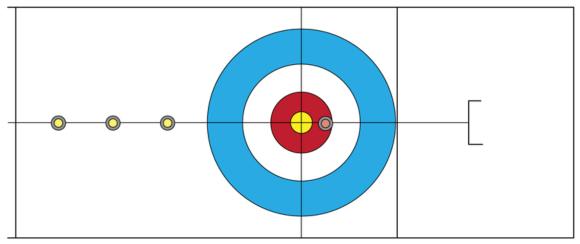Curling Rules and How to Play
This is an excerpt from Curling: Steps to Success by Sean Turriff.
A mixed doubles curling team consists of a pair of players, one male and the other female. Standard curling sheets are used, and normal delivery rules apply. Typically games are eight ends in length. Thankfully, the skills you have learned up to this point still apply in the game of mixed doubles. The real changes are in how the game proceeds.
Each team throws five rocks rather than eight. One player throws the first and fifth stones, and the other player throws the second, third, and fourth stones. Teams may choose to change which of the pair throws the first and fifth stones from end to end. This is one major difference from the four-person game, where players cannot rotate positions within a game.
Each team has one additional stone placed within the playing area at one of two specific spots on the sheet. To be clear, each team gets six stones that can potentially be in play. They throw only five of those stones, since both teams have one stone in play before the endbegins.
The first placement option is behind the tee line at the center line, touching the 4-foot circle as shown in figure 10.1. The second option is a center guard, the depth of which is predetermined before the game and depends on the amount of curl on the sheet. If conditions allow for more curl, the guard placement is closer to the rings. Standard placement is about halfway between the rings and the hog line. Figure 10.1 shows the three possible placements for the yellow stone, only one of which will be used throughout the game.

Initial setup.
In the traditional team game, the team with the hammer throws the second stone of the end. In mixed doubles, however, the team with the hammer gets to choose rock placement, which in turn determines who throws last rock. The team whose rock is placed out front of the house must throw the first rock of the end. The result of this rule is that the team with the hammer may choose to throw the first rock of the next end if they choose to position their stone out front of the rings to start the end.
The next major difference between the mixed doubles game and the traditional team game is with respect to the free guard zone rule. Recall that in the traditional game, your team is not allowed to remove an opposing rock positioned within the free guard zone (FGZ) until the fifth shot of the end. Stones within the rings are allowed to be removed under this rule, and you can remove your own stones if you so desire even if they are in the free guard zone. The modified FGZ rule in mixed doubles states that no rocks, even the ones initially placed to start the end, may be removed before the fourth delivered rock of the end. This means rocks in the rings and guards are all protected until that shot. Also, it means you cannot remove your own guards or stones in the rings. If a violation of this rule occurs, the stones are repositioned at the discretion of the nonoffending team to where they were before the shot, and the shot is considered spent. To help clarify how this works, if team A throws first in the end, that shot cannot be a takeout of any stone. Team B's first shot, the second shot of the end, also cannot be a takeout. Team A's second shot, the third of the end, cannot be a takeout, but team B's second shot, being the fourth shot of the end, may be a takeout. Every shot from there on during the end may be a takeout if desired.
Scoring in mixed doubles is the same as it is in the traditional team game, and the two initial stones are eligible to be counted if they are moved into a scoring position. Hammer determination during game play is the same as for the four-person game; however, hammer has a slightly different meaning in that the team that scored gets a choice of rock placement and accompanying throwing order rather than automatic last-rock advantage. One other slight change to the scoring rules is that if an end is blanked (i.e., no team scores), then the hammer, or decision on initial rock placement, changes between teams. In the traditional game, blanking an end is a tactic that can be used to maintain last-rock advantage into a subsequent end. In mixed doubles, a blank means losing the advantage of hammer.
Learn more about Curling: Steps to Success.
More Excerpts From Curling: Steps to SuccessSHOP

Get the latest insights with regular newsletters, plus periodic product information and special insider offers.
JOIN NOW


